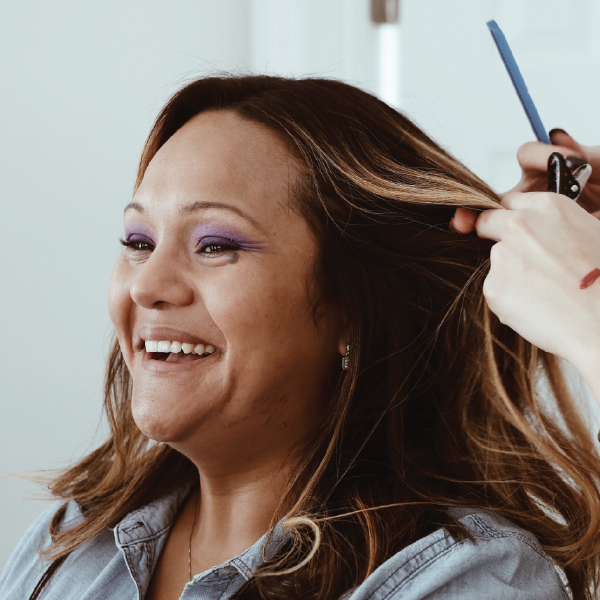Learn more about the approval of a new drug, BIMZELX (bimekizumab-bkzx), for people with moderate to severe plaque psoriasis.
A DERMATOLOGIST WITH PSORIASIS SHARES HER TOP HOME REMEDIES FOR SOOTHING SKIN
A DERMATOLOGIST WITH PSORIASIS SHARES HER TOP HOME REMEDIES FOR SOOTHING SKIN
October 29, 2020
Kelsey Kloss

If you live with psoriasis, you know the toll it can take on your everyday life. Beyond thick, scaly patches, you may experience itching, burning, soreness, swollen and stiff joints, and a number of other symptoms.
You’re certainly not alone: In the United States, psoriasis is a common autoimmune disease that affects more than 7 million adults, per a 2014 study in the Journal of the American Academy of Dermatology. However, that doesn’t stop misperceptions about the condition from running rampant.
“Some people can be mean about it, and even other doctors who are in other fields may not understand psoriasis, how to treat it, or what it’s like to live with it,” says Anna Chacon, MD, a board-certified dermatologist at Cleveland Clinic in Florida and expert medical writer for ZelenLife.com.
Dr. Chacon has psoriasis herself and has experienced scaling on her feet, hands, and scalp. She recalls an incident in which a surgery professor during her intern year of medical training incorrectly assumed that individuals with psoriasis (including herself and another team member) have an infection.
“A lot of people think psoriasis is an infection or that patients with psoriasis don’t have good hygiene, but psoriasis is an autoimmune inflammatory condition that causes scaling and thickening of the skin,” Dr. Chacon says. “It can happen to anyone.”
Because of the symptoms and misconceptions Dr. Chacon has experienced as a result of her psoriasis, she says she’s able to better connect with her psoriasis patients and provide her own best tips and remedies for them.
“It’s hard to live with psoriasis because it’s not only a visual ailment, but it also affects self-esteem and causes symptoms like itching, scaling, and joint pains,” says Dr. Chacon. “Having psoriasis myself definitely makes it easier to talk to patients, because I always remember my own experience and how I’ve felt.”
If you have psoriasis, it’s important to maintain a healthy lifestyle that includes eating healthy, exercising regularly, and managing stress. Although psoriasis is genetic, other factors can worsen it or trigger flares (like stress or illness), per the National Institutes of Health. Those with psoriasis are also more prone to psoriatic arthritis, cardiovascular problems, obesity, high blood pressure, and diabetes.
Talk to your dermatologist about a specific medical treatment plan for your particular type of psoriasis.
However, these tips from Dr. Chacon — which she regularly uses herself — may also help to soothe your skin along with medical treatment.
1. Shower with warm (not hot) water
People with psoriasis can also have aching joints, particularly if you have psoriatic arthritis. In fact, joint symptoms are sometimes early signs of psoriasis, according to the Mayo Clinic.
“I find that showering with warm water helps, as well as using warm compresses for joints,” says Dr. Chacon. “After being in the pool or the ocean, a quick shower right after is also really helpful for preventing flares that can be uncomfortable.”
While warm water may help sore joints, definitely avoid hot water, which can dry out your skin.
Other bathing tips for psoriasis-prone skin from the American Academy of Dermatology (AAD).
- Take just one bath or shower per day
- Keep baths to 15 minutes or less and showers to five minutes or less
- Wash your skin very gently with your hands rather than a loofah or washcloth to prevent irritation
2. Add oil to your shower routine
Dr. Chacon also uses body oil in the shower, especially if she’s in a dry environment and doesn’t have time to moisturize afterward.
“I shower with body oil after lathering up with soap, which helps to moisturize my skin,” says Dr. Chacon. “Showering with body oil usually allows for more hydration. It’s also important not to overdo it with soap, which a lot of people are doing since we’re dealing with COVID-19.”
When possible, Dr. Chacon recommends also moisturizing immediately after your shower.
“That’s a good time to put on moisturizers or emollients because the skin is humid and retains the moisture,” says Dr. Chacon. (Moisturizers add moisture to the skin, while emollients soften the skin and are often an ingredient in moisturizers.)
In fact, the AAD recommends drying your skin gently by simply blotting it with a towel, leaving a little water so your skin remains damp.
Try it: Neutrogena Lightweight Body Oil, $14.97; Amazon.com
3. Moisturize with petroleum jelly
No need to break the bank on expensive moisturizers: Petroleum jelly (Vaseline) is Dr. Chacon’s top pick for soothing scaly and dry skin.
“It’s my favorite moisturizer and emollient in dermatology to recommend to everyone because it’s affordable, it’s found everywhere, and it comes in all kinds of sizes,” she says. “It helps to reduce scales and promote hydration by restoring the impaired skin barrier.”
You can even purchase small Vaseline travel jars that are easy to toss in a bag or keep in your car for on-the-go moisturizing.
“Although it is a thick, greasy emollient, Vaseline can and will moisturize anything,” says Dr. Chacon. “It also helps to prevent the embarrassing white scaling and dandruff that scatters on your clothing when you have psoriasis.”
Dr. Chacon says she manages the thick psoriasis plaques on her feet by applying Vaseline and then putting on a pair of cotton socks.
Other experts agree: Emollients like petroleum jelly should be used liberally and frequently to avoid skin dryness in those with psoriasis, per a 2017 review in the Indian Dermatology Online Journal. “Emollients form the backbone of therapy for psoriasis,” note the review authors. “They are a valuable first-line treatment because dry skin is common in psoriasis and adds to its irritability.”
Try it: Vaseline BlueSeal Series (Variety Pack), $9.92; Amazon.com
4. Use natural oils on your scalp
“The worst area where I have psoriasis is on the scalp, and it’s caused a lot of embarrassing dandruff, itching, and when it was poorly controlled, even hair loss,” says Dr. Chacon. “Natural oils like jojoba oil and coconut oil are helpful for reducing scales on the scalp.”
If you don’t want to feel too greasy on your way out the door, apply the oil to your scalp at bedtime. As a bonus, you may get an extra healing boost: Your skin actually does most of its repair work at night, Dr. Chacon adds.
Coal tar shampoo, often recommended for patients with psoriasis, can also be helpful for soothing scalp irritation. “Sometimes I mix it with regular shampoos and conditioners,” says Dr. Chacon.
Less expensive than most psoriasis treatments, coal tar can be used long-term to effectively treat plaque-type psoriasis, itch, and scaling. Dermatologists have been prescribing coal tar for more than a century to treat psoriasis — but some patients, like women who are pregnant or breastfeeding, should avoid it, per the AAD.
Try it: Organic Jojoba Oil, $9.99; Amazon.com
Try it: MG217 Psoriasis 3% Coal Tar Shampoo, $6.19; Amazon.com
5. Ask your dermatologist about salicylic acid
You may need prescription-strength salicylic acid to help remove psoriasis scales. Salicylic acid works by softening keratin, a structural protein in the skin.
“I use a 6 percent concentration of salicylic acid whenever I have a lot of rough scales on the feet that I want to tone down,” says Dr. Chacon. “However, it’s something that needs to be used in moderation, because it can make your skin sensitive and irritated by breaking down keratin.”
If you’d like to try an over-the-counter remedy for thick scales, CeraVe SA Lotion exfoliates with salicylic acid and lactic acid (which also breaks down keratin). Dr. Chacon also recommends Amlactin, which uses lactic acid to exfoliate tough skin.
Try it: CeraVe SA Cream, $19.97; Amazon.com
Try it: Amlactin Foot Repair Foot Cream Therapy, $7.79; Amazon.com
6. Get outside for sun and (if possible) sea
Because her psoriasis is “relatively under control,” Dr. Chacon uses mostly uses topical treatments at this time. “Sometimes I use a topical vitamin D ointment, however it is not practical or affordable for many patients because it is hard to find insurance coverage for this treatment,” she says.
That said, she also gets vitamin D and soothes psoriasis symptoms by spending time outside in the sun and sea. “I use phototherapy and balneotherapy [immersion in mineral water], mostly by going into the ocean,” says Dr. Chacon. “The combination of minerals, direct sunlight — with sun protection and sunscreen of course — is therapeutic and is feasible to do in a climate like the one in South Florida.”
Short exposure to sunlight or ultraviolet (UV) light may also help control psoriasis symptoms, according to Michigan Medicine. However, it’s important to avoid too much sun, which can damage the skin, cause skin cancer, and trigger flares of psoriasis if you get a sunburn.
Even if you don’t live by the ocean, you can soak to soothe your psoriasis in other ways. “I also like to use coal tar baths, a very old-school regimen,” says Dr. Chacon.
Some medical centers provide coal tar bath treatments, which may be paired with prescription phototherapy (light therapy), says Dr. Chacon. Talk to your dermatologist about which options are available to you.
The Importance of Medication for Psoriasis
For many psoriasis patients, home remedies and topical treatments are part of an overall treatment plan that includes medication to control the underlying cause of psoriasis: an overactive immune system.
Mild cases of psoriasis may respond to topic medication, such as steroid creams or other prescription creams.
But for moderate or severe cases of psoriasis, your dermatologist will likely recommend systemic medication. This means taking an oral pill or getting injections or infusions of medications to tamp down the overactive immune system that is causing psoriasis plaques.
“This is an individual decision that I usually make in conjunction with the patient’s needs and concerns about their quality of life,” says Dr. Chacon. “Most of it has to do with TBSA (total body surface area of involvement), presence of joint pains, and unresponsiveness to treatment. This is when I usually have a discussion about the possibility of including a systemic medication, whether it be an oral or injectable therapy for greater efficacy and better results.”
For Dr. Chacon, having experienced psoriasis herself shapes how she advises patients in finding the right medication.
“Going through dermatologic and medical conditions has undoubtedly made me a better, and more empathetic physician,” says Dr. Chacon. “I like to think it has made me relatable to others, and makes it easier to understand what it means to be in their shoes.”
8 Ways to Stop Baths and Showers From Worsening Your Psoriasis. American Academy of Dermatology. October 21, 2020. https://www.aad.org/public/diseases/psoriasis/skin-care/baths-showers.
Interview with Anna Chacon, MD, a board-certified dermatologist at Cleveland Clinic in Florida
Psoriasis. Mayo Clinic. May 2, 2020. https://www.mayoclinic.org/diseases-conditions/psoriasis/symptoms-causes/syc-20355840.
Psoriasis. Michigan Medicine. October 30, 2019. https://www.uofmhealth.org/health-library/hw58469.
Psoriasis. National Institute of Arthritis and Musculoskeletal and Skin Diseases. March 2017. https://www.niams.nih.gov/health-topics/psoriasis.
Psoriasis Treatment: Coal Tar. American Academy of Dermatology. October 21, 2020. https://www.aad.org/public/diseases/psoriasis/treatment/medications/coal-tar.
Rachakonda, TD et al. Psoriasis prevalence among adults in the United States. Journal of the American Academy of Dermatology. January 6, 2014. doi: https://doi.org/10.1016/j.jaad.2013.11.013.
Torsekar R, et al. Topical Therapies in Psoriasis. Indian Dermatology Online Journal. July-August 2017. doi: https://doi.org/10.4103/2229-5178.209622.
SUBSCRIBE TO GHLF
RELATED POST AND PAGES
_
Was this article helpful?
YesNo




This Post Has 0 Comments